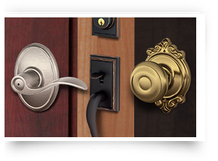This type of lock is the least secure. It is simply a lock that is contained within the handle of a door. It works by preventing the handle from rotating. This type of lock is usually used on bathroom doors and other inside entryways because it is so easy to break. Another lock of this kind consists of a button that is found immediately next to the door handle, and it works in the same way.
Deadbolts
Deadbolts provide security through the use of a solid metal cylinder that protrudes through the door jam and into the wall to completely secure the door. Deadbolts are often found in use with door handle locks to add a second level of protection. Deadbolts require a key to lock them from the outside and for most residential homes deadbolts provide more than enough security for doors leading outside when properly installed.
Keyless Locks
Keyless locks work just like their name implies. Using no key for entry, the door is locked and unlocked using a code that is entered into a keypad. This adds yet another level of security and keyless locks typically employ a deadbolt. Keyless locks are often found in commercial buildings and other places where heightened security is a necessity. Keyless locks are found in building doors and car doors alike.
Electric Locks
Electric lock devices work like any lock, only they are not manually applied. The mechanism that locks and unlocks the door is running through electronics, but they can be opened with either a key or through a code on a keypad.
Combination Locks
A combination lock is much like a keyless entry, only the keypad functions through a push button mechanism. Rather than a digital or electronic coding device, the keypad on combination locks triggers the movement of a deadbolt mechanically.
The many types of door locks correspond to different doors found in buildings and cars and to the need for extra security at some locations. From simple locks found inside the home to extremely high tech electric locking systems found in sensitive areas, there is a door lock for every need and preference.


